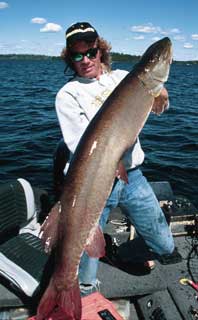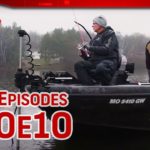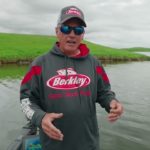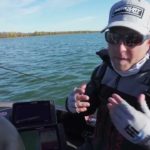Dog Days are Prime Time for Trolled Spinnerbaits
 The Dog Days of summer are supposed to be tough times for anglers. But for muskie anglers, the heat of summer, from late July through early September, can be one of the most consistent and predictable bites of the year. Water temperatures are at their peak. The instability and unpredictability of the early summer transition period has passed, and fish are established in summer patterns. Given stable weather, fish activity can be, if not high, then at least consistent, and remain consistent for extended periods of time.
The Dog Days of summer are supposed to be tough times for anglers. But for muskie anglers, the heat of summer, from late July through early September, can be one of the most consistent and predictable bites of the year. Water temperatures are at their peak. The instability and unpredictability of the early summer transition period has passed, and fish are established in summer patterns. Given stable weather, fish activity can be, if not high, then at least consistent, and remain consistent for extended periods of time.
On many of Minnesota’s muskie waters, much of that fish activity centers around shallow to mid-depth flats, often weed flats, but sometimes sandgrass flats, or even bare sand.
Fishing flats efficiently using traditional summertime casting techniques can be a challenging and time-consuming effort. On many waters, flats extend for hundreds of yards in length and breadth, and on large lakes, can literally go on for miles. On a given day, fish using the flats may be on the inside weed edge, spread across the top of the flat relating to isolated thick clumps of weeds, small rock piles, and depressions on an otherwise featureless bottom, or at or just off the flat’s edge where weedgrowth stops and the flat breaks off into the main lake basin. Many days, it’s all of the above depending on time of day, fishing pressure, weather, and a host of other factors.
Faced with the necessity of covering all the bases efficiently to put a bait in front of as many potential biters as possible, trolling seems an obvious choice. Crankbaits, while standard trolling tools at other times of year, aren’t well suited to the varied depths and cover conditions of summertime flats. Spinnerbaits, though, can be worked at a variety of depths and come through or over even fairly dense weeds, making contact with cover – a potent trigger for summertime fish – without fouling. For quickly searching flats, trolling spinnerbaits excels in efficiency, and fish catching ability.
The basics of spinnerbait trolling are simple. Using your main outboard or a kicker motor, quickly pull large tandem spinnerbaits such as the Ruff Tackle Tandem Rad Dog, large CJ’s Tandems, or the Lindy M&G Tandem over and across flats and down weed edges, making repeated pass to cover the entire flat.
Simple enough…right? Using trolled spinnerbaits to their greatest potential, though, takes a little practice, and some attention to detail, particularly when it comes to the lure‘s speed and running depth.
Speed and running depth are always critical presentation factors. When spinnerbait trolling, the two factors become even more closely related. With spinnerbaits, speed equals lift. Slow down, diminishing the lift, and the bait runs deeper. Accelerate, and it runs higher. The relationship between speed and running depth is an important component of effectively trolling spinnerbaits. Flats are rarely uniform in depth or cover density. Weed cover varies not only in density but in how close stalks grow to the surface. By carefully controlling running depth, spinnerbaits can be run just over the tops of heavier weeds, dropped slightly deeper in areas of sparse or deeper growth, even fluttered down weed edges or areas of confined open water between points on a flat’s edge.
 How far back should spinnerbaits run? Most often, between 85 and 100 feet behind the boat is a good starting point. Though there are days when baits running in the prop wash as little as 7 feet back can be effective, longer lines are a better starting point day in and day out because long lines allow you to easily adjust the lure’s running depth to react to changes in weedgrowth height and density. Accelerate (increasing lift) to hop baits over taller stands of weeds, then slow down to tickle the tops of deeper growth. Long lines also allow you to precisely steer baits across key pieces of structure. Turn out and accelerate to rip lures across small points along a weedline. As you turn and increase speed the lure will swing across the point, changing speed and direction – key triggers for muskies. Good electronics help spot changes in weedgrowth, and a GPS unit can be helpful as well. Mark points, thick stands of weeds and inside turns with icons or waypoints to help you hit them right on your next trolling pass.
How far back should spinnerbaits run? Most often, between 85 and 100 feet behind the boat is a good starting point. Though there are days when baits running in the prop wash as little as 7 feet back can be effective, longer lines are a better starting point day in and day out because long lines allow you to easily adjust the lure’s running depth to react to changes in weedgrowth height and density. Accelerate (increasing lift) to hop baits over taller stands of weeds, then slow down to tickle the tops of deeper growth. Long lines also allow you to precisely steer baits across key pieces of structure. Turn out and accelerate to rip lures across small points along a weedline. As you turn and increase speed the lure will swing across the point, changing speed and direction – key triggers for muskies. Good electronics help spot changes in weedgrowth, and a GPS unit can be helpful as well. Mark points, thick stands of weeds and inside turns with icons or waypoints to help you hit them right on your next trolling pass.
How fast? Probably faster than you’re used to. Typical spinnerbait trolling speeds range from 3.5 to 5.5 miles per hour, with bursts of speed well over that. Efficiency and covering water quickly are the name of the game here, so troll as fast as you can without lures ‘blowing out’ (popping to the surface), and vary your speed to adjust running depth.
As you might expect, a 25-pound fish hitting a bait moving 5+ miles per hour is a less a strike than a collision. Good quality, large capacity levelwind reels with a smooth drag such as the Abu-Garcia 7000 are a must. Line counters such as the Shimano Tekota have exceptionally smooth drags, and line counters add a convenience factor when setting line length. No line counter? Simple repeatability by counting passes of the levelwind is usually precise enough. Drags should be set so they just slip when the boat accelerates rapidly. Any tighter, and something – rod, leader, line or rodholder – will fail when a fish hits.
Match the reel with a fairly stiff rod – most bucktail rods work well for spinnerbait trolling. Stiffer rods let you see baits working better so you can tell if you’ve picked up a weed, and rip through weed tops better than softer rods most often used for muskie trolling. Long rods like the 8 foot 6 inch Pete Maina Bass Pro Shops Signature Series have the right action for pulling spinnerbaits, and the extra length helps spread lines with multiple anglers in the boat. Finish things off with a 4 foot, single strand wire leader.





